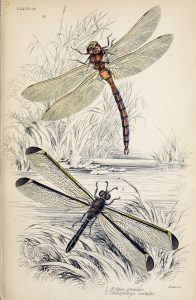Aeshna grandis
Seabhcaí Ómrach

Author James Duncan Editor Sir William Jardine, Jardine Naturalist’s library Entomology Plate 28, marked as public domain, more details on Wikimedia Commons
The brown hawker is large common dragonfly found in Ireland, it is distinctive because of its chocolate brown colouring. They grow to 7.3cm long and have a wingspan of 10.2cm. Both males and females are similar looking but can be distinguished as males have blue dots on their abdomen while the females have yellow dots along their abdomen.
They can be found along canals, marshes and reed-beds they are called hawkers because of the way in which they hunt, they fly over wide areas and snatch the prey out of mid-air. They are very protective of their hunting grounds and defend them aggressively.
Female dragonflies can lay hundreds of eggs during their life, Hawkers lay Endophytic eggs they are elongated and are injected into plant stems, wood or mud near the water surface. As they develop they hatch and moult quickly finding safety in the water. Dragonflies spend most of their lives as larva eating as much as they can and moulting several more times.
Hawker dragonflies have larger eyes and hunt by sight among plants, they hunt other insect larvae, crustaceans, worms, snails, leeches, tadpoles and small fish. Depending on the temperature of the water and species they development of the larva can take about two years.
The final moult of the larvae takes place out of the water, it is triggered by day length and the temperature, hawker dragonflies emerge during the night after finding a secure spot they push out of the larval body and wait for their legs and wings to harden. This process can last up to three hours during this time they are most vulnerable to predation.
The newly emerged dragonflies, called Tenerals, feed for about a week before moving back to the water to breed. In general most species of dragonflies don’t last more than two weeks, but some live for up to 6 weeks. (Smallshire & Swash, 2014) They fly from June to September.
In Irish mythology it’s believed that fairies use dragonflies to travel from place to place. In some cases it’s believed that dragonflies are fairies in disguise!
Featured image by Darkone contribs) (https://commons.wikimedia.org/wiki/File:Braune_Mosaikjungfer_(Aeshna_grandis).jpg), “Braune Mosaikjungfer (Aeshna grandis)”, https://creativecommons.org/licenses/by-sa/2.5/legalcode